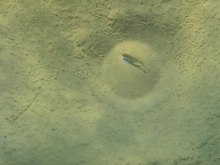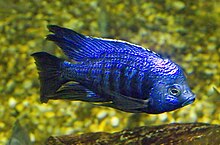Copadichromis
| Copadichromis | ||||||||||||
|---|---|---|---|---|---|---|---|---|---|---|---|---|

|
||||||||||||
| Systematics | ||||||||||||
|
||||||||||||
| Scientific name | ||||||||||||
| Copadichromis | ||||||||||||
| Eccles & Trewavas , 1989 |
Copadichromis (from the Greek kopadi = "school (of fish)", and Chromis , a genus of damselfish ) is a genus of East African cichlids that are endemic to Lake Malawi , the Upper Shire and Lake Malombes . Together with the six species of the genus Mchenga , Copadichromis formsthe cichlid group of the Utaka , which do not live directly on the coast but in large schools in the open water and play an important role in fishing.
features
Depending on the species, Copadichromis can be between 9 and 19 centimeters long. The body is slim and clearly flattened on the sides. The caudal fin is relatively large and usually slightly indented. Outside of the breeding season, the animals are usually colored silver-gray. The small mouth, which is adapted to catching small prey ( zooplankton ), is characteristic of the genus . The mouth is jerked forward in a tubular shape, creating a vacuum that sucks in the prey.
Way of life
Utaka like Copadichromis are not tied to rocky habitats like Mbuna , but live in sometimes very large swarms of several thousand individuals and also different species in the open water, but near the rocky coast or over sandy soils. They feed on small planktonic crustaceans , which they snap open with their outstretched mouth while swimming against the current and fixing with their large eyes. Like almost all cichlids in Lake Malawi, the Copadichromis species are mouthbrooders . During the breeding season, almost all species move close to the shore and the males stay true to their location over sandy soils, show a bright brood color and build sand hollows in which they spawn . Then the females pick up the eggs with their mouths to care for the brood. Since different species spawn at the same time, large schools of young fish of the same size form after brood care has ended and move into the open water.
species


So far, 25 species have been described:
- Copadichromis atripinnis Stauffer & Sato, 2002
- Copadichromis azureus Konings, 1990
- Copadichromis boadzulu (Iles, 1960)
- Copadichromis borleyi (Iles, 1960)
- Copadichromis chizumuluensis Stauffer & Konings, 2006
- Copadichromis chrysonotus (Boulenger, 1908)
- Copadichromis cyaneus (Trewavas, 1935)
- Copadichromis cyanocephalus Stauffer & Konings, 2006
- Copadichromis diplostigma Stauffer & Konings, 2006
- Copadichromis geertsi Konings, 1999
- Copadichromis ilesi Konings, 1999
- Copadichromis insularis Stauffer & Konings, 2006
- Copadichromis jacksoni (Iles, 1960)
- Copadichromis likomae (Iles, 1960)
- Copadichromis mbenjii Konings, 1990
- Copadichromis melas Stauffer & Konings, 2006
- Copadichromis mloto (Iles, 1960)
- Copadichromis nkatae (Iles, 1960)
- Copadichromis parvus Stauffer & Konings, 2006
- Copadichromis pleurostigma (Trewavas, 1935)
- Copadichromis pleurostigmoides (Iles, 1960)
- Copadichromis prostoma (Trewavas, 1935)
- Copadichromis quadrimaculatus (Regan, 1922) ( type species )
- Copadichromis trewavasae Konings, 1999
- Copadichromis trimaculatus (Iles, 1960)
- Copadichromis verduyni Konings, 1990
- Copadichromis virginalis (Iles, 1960)
literature
- Thomas Derrick Iles (1960): A group of zooplankton feeders of the genus Haplochromis (Cichlidae) in Lake Nyasa . Annals and Magazine of Natural History (Series 13) v. 2 (no.17), PDF
- Horst Linke, Wolfgang Staeck: African cichlids, cichlids from East Africa. Page 54, Tetra Verlag, 1981, ISBN 3-8974-5103-4 .
- Erwin Schraml: Copadichromis , Copadichromis […]. In: Claus Schaefer, Torsten Schröer (Hrsg.): The large lexicon of aquaristics. Eugen Ulmer, Stuttgart 2004, ISBN 3-8001-7497-9 , p. 252 f.
Web links
- Copadichromis on Fishbase.org (English)